Freediving Fins vs. SCUBA Fins: Which Should You Get?
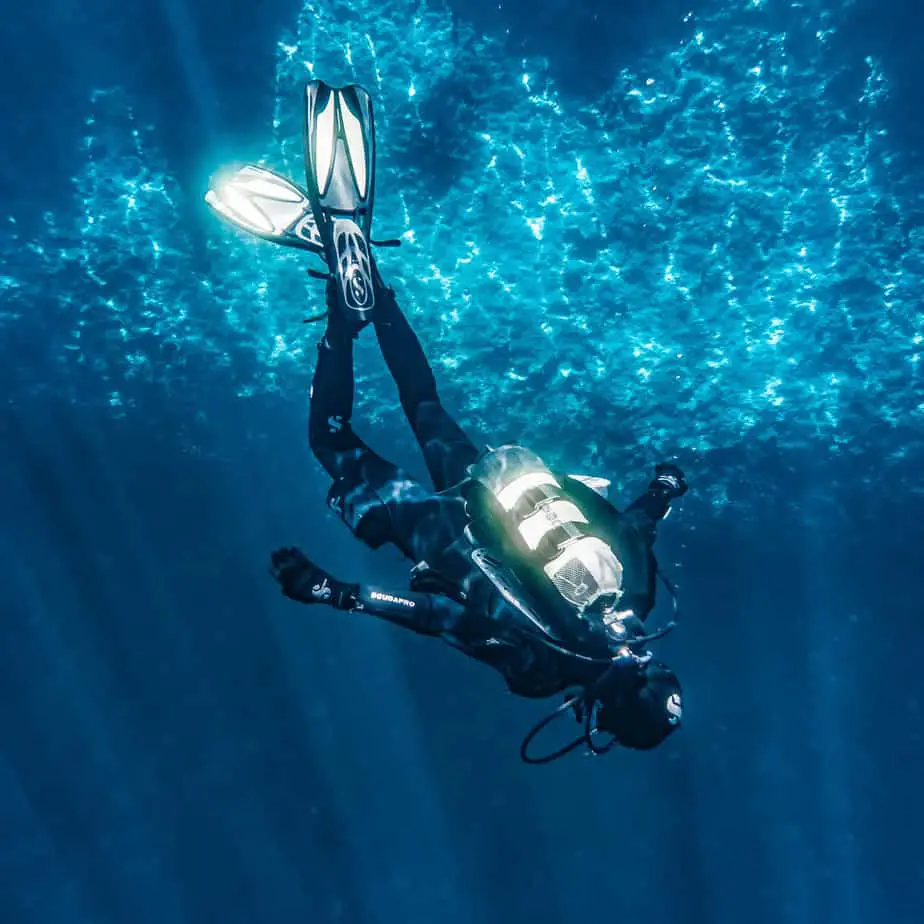
Whether you’re freediving, SCUBA diving, or snorkeling, one piece of equipment you’ll need for each activity is your fins. With that said, that doesn’t mean you can use the same fins for each one. Fins come in numerous shapes and sizes, and using the wrong fin for the sport you are participating in can drastically reduce your performance.
With so many fins on the market, it can be overwhelming for a beginner to know which one to get. Contrary to popular belief, bigger is not always better, and it largely depends on what kind of diving you plan on doing. Since fins are specifically designed for performance at various depths, the length and material of your fins will affect how maneuverable it is underwater. This is where knowing the difference between freediving and SCUBA fins will make a big difference.
Table of Contents
Freediving Fins and SCUBA Fins
Comparing freediving fins to SCUBA fins is not as straightforward as it may seem.
For one, freediving fins are significantly longer than SCUBA fins. Thus, freediving fins require more leg power to kick with and can restrict fine movement underwater. However, the length of the freediving fins is also what allows it to generate so much thrust with each kick.
With SCUBA fins, you will not feel as much propulsion compared to freediving fins. You can use them in tighter spaces, and can perform more precise kicks and turns underwater. Additionally, an open foot pocket design is recommended for SCUBA fins since you’ll want to wear dive boots with it, whereas freediving fins must maximize performance, therefore a full-foot pocket design is the optimal choice.
If I can only pick one, which should I get?
If you freedive and SCUBA dive and want only one pair of fins to use for both activities, then we recommend buying a pair of freediving fins. Freediving fins are very powerful and can help you swim against strong currents.
Furthermore, they are more efficient when it comes to air consumption if you are just cruising along. After all, freedivers only have one breath to work with, so you know that each piece of equipment worn only serves to be as air efficient as possible.
Next, the speed and energy efficiency of the freediving fins make them ideal to use, especially if something were to go wrong and you need to resurface immediately. When you use freediving fins, your legs may feel sore initially, but once you acclimate to them and adopt a slower, wider amplitude kick, you will jet through the water easily.
So whether you are SCUBA diving or freediving, you can use freediving fins to great effect. However, if you tried to use SCUBA fins for freediving, you will feel sorely lacking in terms of power and speed, which can be dangerous when you are deep underwater and fighting against the negative buoyancy.
Lastly, a piece of advice: do NOT freedive after SCUBA diving. If you want to do both activities in one day, freedive first, SCUBA second. The reason being, after spending some time in the water the residual nitrogen in your blood from your SCUBA session combined with the rapid ascents while freediving can easily result in decompression sickness.
SCUBA Diving Fins
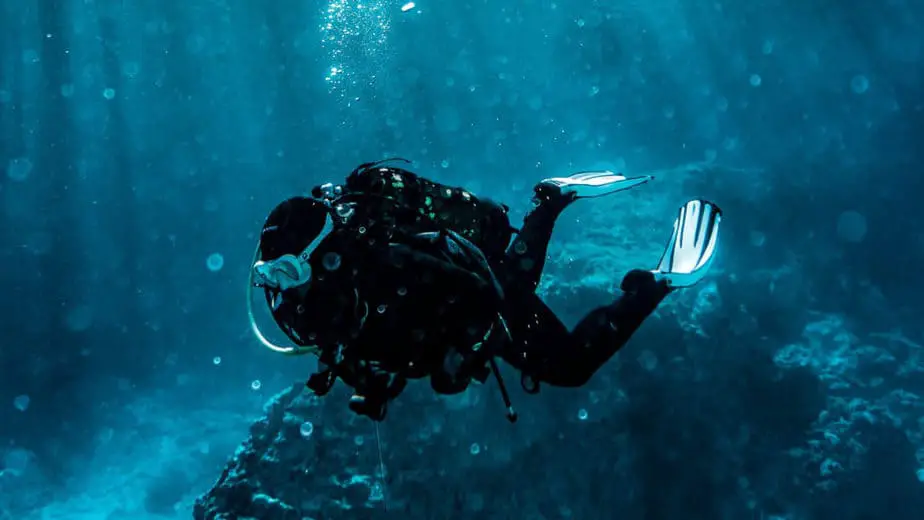
SCUBA fins are a step up from snorkeling fins, and they are designed to withstand the pressure at deeper depths while giving you adequate power, though not as much as freediving fins. Keep in mind that the volume and weight of your SCUBA gear will make you less hydrodynamic, so stiffer fins that generate more thrust is necessary.
The blade length and flexibility of SCUBA fins is generally longer than snorkeling fins, and they measure between 25 to 30 inches (64 to 76 cm). SCUBA fins may feature various designs that increase their control and kick efficiency. For instance, innovations such as a split fin design or integrated channels allow the diver to kick rapidly while kicking fatigue to a minimum.
Due to their length, diving fins will feel stiffer and more rigid, which helps to increase the propulsion you can get. However, your leg muscles will get worked harder to move them; this is especially true for freediving fins, which are very long.
SCUBA diving fins typically have an open heel design so that dive boots can be worn with them for increased insulation and comfort.
Overall, SCUBA fins feature a more streamlined design, medium length blades (longer than snorkeling fins, shorter than freediving fins), thick and stiff materials, spacious foot pockets for dive boots, and decent thrust with each kick.
Freediving Fins
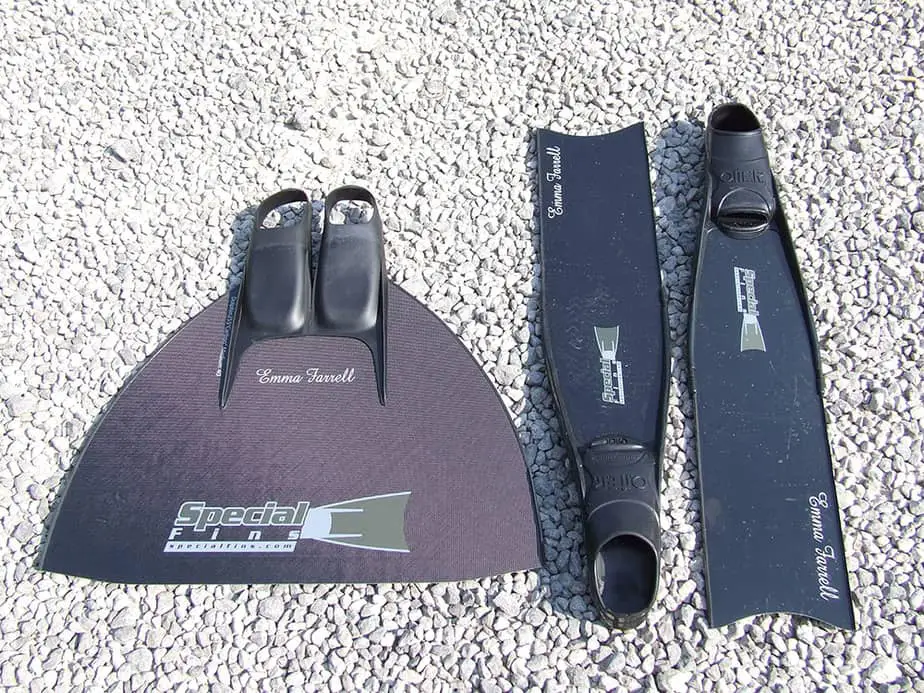
Freediving bi-fins are highly recognized thanks to their extremely long blade length. The most basic freediving fins measure anywhere from 31 to 38 inches (79 to 97 cm) and that’s excluding the foot pocket length.
The reason for their excessive length is so that freediving fins can displace the greatest amount of water per kick. In other words, the freediver can propel themself rapidly through the water like a torpedo. They can cover greater distances faster, with less energy and oxygen used so that they can stay underwater for longer.
Unfortunately, such long fins are difficult to maneuver. First of all, forget trying to walk around with them on land. Second, maneuvering them to do precise movements requires a significant amount of experience.
As for its flexibility, freediving fins are very stiff. However, thanks to their long blade length, this means that when it “snaps” back after each kick, you will jet through the water easily. Unfortunately, the stiffness makes it difficult to kick without strong legs. Starting out, you will need to improve your finning technique and strengthen your leg muscles in order to maximize these fins.
The blade material is typically constructed from plastic, fiberglass, or carbon. Performance is key while freediving, so the foot pocket is going to be full foot.
To summarize, freediving bi-fins feature very long blades that are typically made from plastic, fiberglass, or carbon. They typically come with a full foot pocket design. Due to the stiffness of the blades, they can help you perform powerful kicks that need skill and strength to do properly. Since freediving fins are so long, they don’t fit in most fin bags and are difficult to travel with.
Freediving Monofin
Freedivers who intend to compete against the best of the best will eventually switch to using a monofin. As the name suggests, it is a single large fin with a pair of foot pockets attached so that you can wear it with both feet. Its shape is reminiscent of a dolphin’s tail, which is what it is based on.
Switching from bi-fins to a monofin isn’t easy; there is sure to be a learning curve one must overcome. However, it is worth learning and getting used to because monofins are the most efficient fins one can use to propel themselves through the water.
Similar to freediving bi-fins, monofins are made using similar materials: plastic, fiberglass, and carbon. The thickness is greater towards the foot pockets and thinner towards the ends. A stiff blade is harder to kick with but gives you the most thrust. A softer blade will be easier to use but will not provide the same performance.
How to Select the Right Freediving Fins
You don’t want to buy the first freediving fin you see without doing some research. Particularly if you are on a tight budget, you want to get the best bang for your buck, since freediving fins can also be used for SCUBA diving as well. Once you get yourself some gear that is specifically geared towards freediving, you will have a hard time going back to your old SCUBA or snorkeling fins.
Material
The three main materials that freediving fins are constructed out of are plastic, fiberglass, and carbon. That is the order of each type of fin in ascending price brackets.
Let’s start with plastic first. Plastic blades are rugged and inexpensive. If you’ve never owned a freediving fin before, then this is likely what you will start with. For beginner divers and spearos, they are good enough for you to get used to the size and handling of a freediving fin. The goal is to upgrade to either fiberglass or carbon fiber later on.
Fiberglass composites provide superior performance but are more expensive than plastic. Similarly, carbon fins are the next step up from fiberglass. Due to their prohibitively expensive price, all but enthusiast freedivers will likely pass due to the price alone.
They are generally reserved for competition use, or for the most intense spearfishing or pleasure-diving use. The high price is justified thanks to its responsiveness and energy efficiency that cheaper materials cannot match.
Gearing Up
Freediving sounds simple enough;just hold your breath and dive, right? Anyone who has actually dived down to deep depths knows that it is much more than that. And the same is true of freediving gear; specific gear is needed in order to get the best performance while staying safe.
Whether the aim is to dive, fish, or to enter a competition, one needs to purchase gear that is suitable for their capabilities. It is important to know what the intended use is, and what experience level the user is at in order to benefit the most from a pair of freediving fins.
Getting the Right Fit
Figuring out the sizing of a full-foot fin can be cumbersome, and unfortunately sizing may be an issue for freediving fins as well. In fact, when it comes to freediving fins, it is crucial that they fit perfectly on a diver’s foot as if they were an extension of it in order to get top performance from the fins.
Otherwise, a fin that is even slightly loose can cause you to worry that it will slip off as well as waste energy with each kick. Additionally, there are sizing differences between each manufacturer, so you should find the company’s sizing chart as well as consult customer reviews or ask the manufacturer directly for details.
Generally dive boots are worn when using fins with open foot pockets. Full foot pockets can be worn barefoot but this may cause discomfort. Wearing neoprene underwater socks can help you get a more comfortable fit while keeping your feet warm. Some manufacturers assume that you will be wearing neoprene socks of a particular thickness (around 1.5-3mm).
Once again, consult the sizing chart or read customer reviews to get an idea of how they might fit on your feet. Decide whether you plan on wearing neoprene socks or going barefoot and pick an appropriate size. When going barefoot, we recommend looking for fins that have soft rubber on contact areas by the foot pocket.
Some manufacturers sell insoles that can be put inside the foot pocket to essentially make the fins a smaller size to help you get a tighter fit. You can also use them if you have thinner socks than normal and need something to pad the space.
If it seems like people go through a lot of trouble to get the perfect fit, that’s because the perfect fit is essential and worth the headache you will get by doing so much trial and error. Freediving fins that are too small will cramp and pinch your feet. Too large, and you might slip out of them when kicking hard. You will also waste precious energy because the energy transfer is not as efficient when your foot is sliding around in the fin.
Freediving Fins vs. SCUBA Fins – Summary
Both freediving fins and SCUBA fins are designed for their respective sports. However, freediving fins can potentially be used for SCUBA diving as well. The long fin blades of the freediving fins make them harder to kick with, however they provide the greatest thrust and will help you conserve oxygen and energy.
Freediving fins are not good when it comes to precise movements, since they are so large and long. As such, they are not ideal for use in shallow water or around coral. If you’re looking to buy a pair of freediving fins, start off with a pair of plastic ones and then upgrade to fiberglass later on.
Using SCUBA fins while freediving is not recommended. Due to their short length, you will not be able to generate much thrust. You will find yourself kicking rapidly, wasting precious energy, while not traveling very far for the energy that you spent. During the ascent when you must fight against negative buoyancy, divers with SCUBA fins will struggle to resurface.
Let’s Dive In
Whether you’re planning on surfing the waves or swimming with sea turtles, our articles will take your water sports knowledge to the next level.
Related Posts
- Why Are Freediving Fins So Long?
- Are Freediving Fins Good for Snorkeling? The Lowdown
- How Much Faster Can You Swim with Flippers?
- Split Fins vs. Blade Fins: Which Design is Better?
- Causes of Freediving Deaths and How to Prevent Them
Affiliate Disclosure
As an Amazon Associate we earn from qualifying purchases.
Freediving Fins vs Scuba Fins: A Detailed Comparison
Let’s settle this Freediving Fins vs Scuba Fins debate once and for all in this article by comparing both the options in depth.
Whether it’s freediving or scuba, the one piece of kit you will need for both activities is “fins”. Hold on! This does not mean that you can use similar fins for both of them.
It is recommended not to use freediving fins while performing scuba diving.
Remember, prevention is better than cure. Right!
Fins come in various sizes and shapes and each is developed for specific activities and conditions. In this article, we will talk about the key variations between freediving fins vs scuba fins.
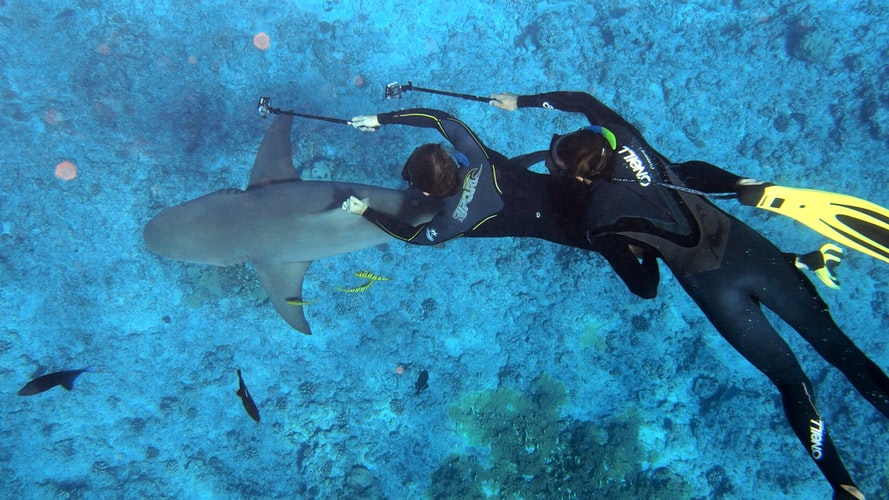
Table Of Contents
- Freediving Fins vs Scuba Fins: Features Comparison & More
- What Are Scuba Fins?
- Some Notable Features of Scuba Fins
- Force Fins:
- Large and wide fins:
- Stunning Fin Strap:
- Propulsion Comfort:
- What Are Freediving Fins?
- Some Notable Features of Freediving Fins
- Blended and separate foot:
- Angle and rails:
- Thick socks:
- Fiberglass blades:
- Freediving Fins vs Scuba Fins: Core Differences Listed
- What Fins to Pick to Perform Both
Freediving Fins vs Scuba Fins: Features Comparison & More
What Are Scuba Fins?
You may look funny as it makes you walk like a penguin, but scuba fins are engineered pieces of special equipment.
These fins are designed for challenging conditions and also aim to provide more power under the water. Scuba fins serve like engines in a car.
Scuba fins come in varying lengths and are flexible. Keep in mind, the longer and harsher the fins are, the more propulsion they will give you. Yes, your muscle will need extra stamina to move with them.
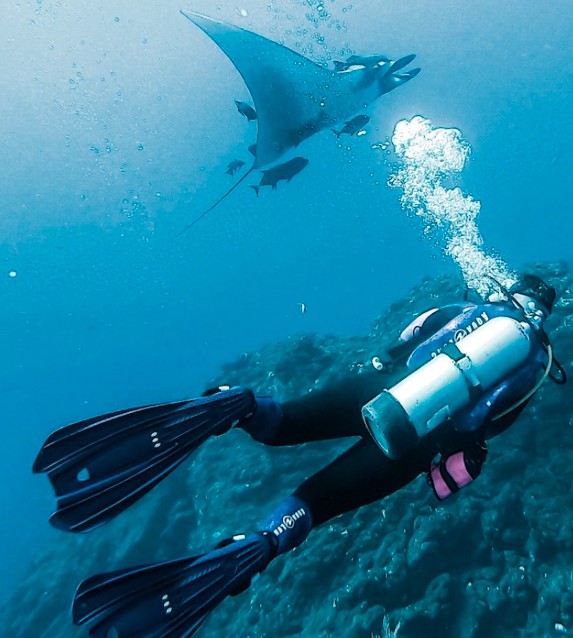
Some Notable Features of Scuba Fins
Force Fins:
This is a distinctive feature of scuba fins. Designed with a v-cut shaped blade, force fins have one toe and heel straps. This is designed to boost speed and save you from any risk while driving.
Large and wide fins:
Large and wide fins will help to reduce the obstruction that you may face during deep-sea diving. These fins help to prevent excess obstacles during swimming.
Stunning Fin Strap:
Have a look at the type of belt while purchasing a diving fin. They are made of the standard strap with an adjustable rubber. This strap can be clipped and unclipped easily.
Propulsion Comfort:
This is the key feature that a diver may look after to make a smooth and easy move in the water without any complication.
What Are Freediving Fins?
The first thing that you notice of a freediver is their fins, long and the elegant ones. It is designed for some technical reasons. The primary objective is to remove a huge amount of water per kick. Freedivers can cover a vast distance with less energy. Freediving fins are gorgeous and they lean in a hypotonic way at the time of finning. These fins are in demand for their expansive surface area compared to other fins.
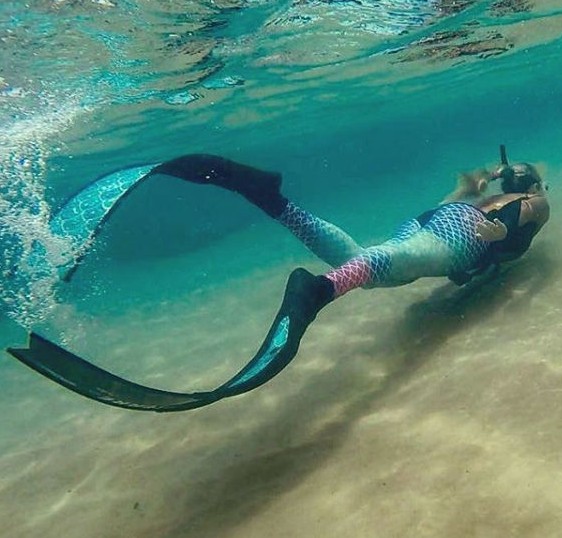
Some Notable Features of Freediving Fins
Blended and separate foot:
Freediving fins have separate foot pockets with two clips and screws attached to it. This helps you to move with the fins wherever you like as they are portable.
Angle and rails:
Freediving fins have thick rails that make the blades stiff. A thin route cannot support the edge, which leads to the breaking of the swimming movement.
Thick socks:
Selecting proper diving socks is important. Get a smooth and thick sock to avoid rubbing your feet against any sea creatures. These socks will help to protect your feet and ankles while diving in icy places.
Fiberglass blades:
These blades are durable and are available within a budget. Fiberglass blades are used to increase efficiency. It is specially designed for them who are looking to improve their diving skills.
Freediving Fins vs Scuba Fins: Core Differences Listed
There is a vast difference between features of freediving fins and scuba fins. Like,
- Freediving fins are lengthier than scuba fins.
- Freediving fins need more leg power to kick underwater than scuba fins.
- Scuba fins are lighter compared to freediving fins.
- Scuba fins are more suitable to be used in tighter space than freediving fins.
What Fins to Pick to Perform Both
In this circumstance, it is advised to go for freediving fins. These fins are powerful enough and will help you to swim against strong water currents. They can be used for several other purposes.
- Freedivers get a chance to take only one breath to work with. Each and every equipment is air efficient. So, if you are planning to just cruise along, these fins will help to consume air.
- Divers are greatly fond of freediving fins particularly due to its speed and efficiency. With the help of this fin, you can resurface immediately at the time of any emergency.
So, whether it’s free diving or scuba diving, a pair of freediving fins is enough for both.
Conclusion
Not all costly fins are perfect for diving. Some are just expensive but don’t work well in practice at all. Never make a mistake of getting fins that will end up with regrets. Both freediving fins and scuba fins are designed for respective sports.
Remember the perfect fit is significant. Do not opt fins either too small or too large.
Always dive not to avoid life, but for life not to escape us! If you like this article on freediving fins vs scuba fins, then consider sharing it so that it can reach to wider audiences.
Rocky loves to live a nomadic life, and he loves travelling a lot. He likes to visit new places, meet new people and learn new culture and language. In this blog he shares his outdoor experiences in field like hiking, camping, fishing and more.
Latest posts by Rocky D (see all)
- Freediving Fins vs Scuba Fins: A Detailed Comparison – February 21, 2022
- How to Use Hammock Straps (A Step by Step Guide) – February 21, 2022
- 8 Best Places to Fish in Ohio (With Complete Details) – February 20, 2022
https://openwaterhq.com/freediving/vs-scuba-fins/https://beingnomadic.com/freediving-fins-vs-scuba-fins/
